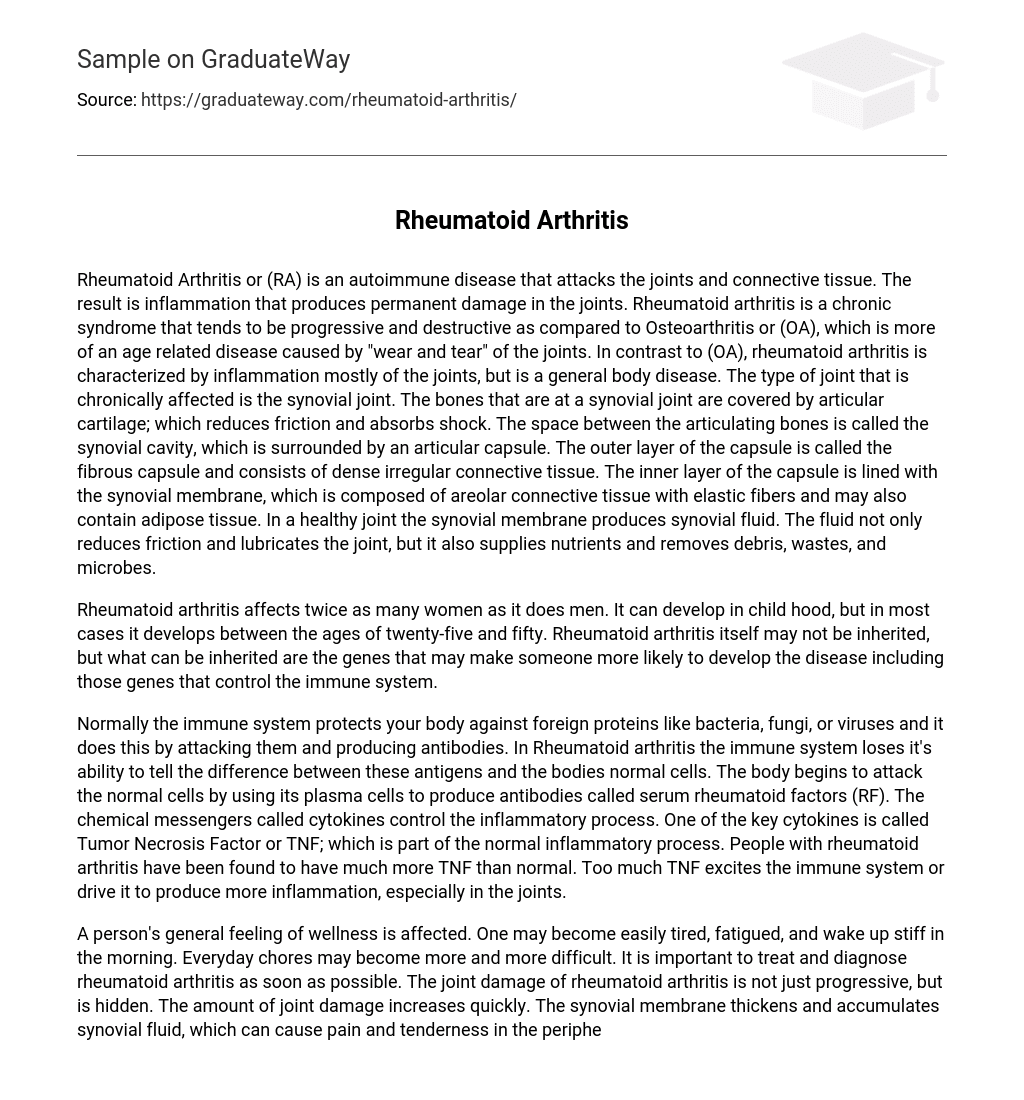Rheumatoid Arthritis (RA) is an autoimmune disease that affects the joints and connective tissue. It is chronic, progressive, and leads to inflammation and permanent damage. In contrast, Osteoarthritis (OA) occurs due to age-related joint deterioration and primarily targets certain joints rather than causing inflammation throughout the body.
The type of joint that is involved is the synovial joint. The articular cartilage at a synovial joint serves to protect the bones by reducing friction and absorbing shock. The space between the bones that articulate with each other is known as the synovial cavity, which is surrounded by an articular capsule. This capsule has an outer layer made up of dense irregular connective tissue known as the fibrous capsule.
The synovial membrane, composed of areolar connective tissue with elastic fibers and possibly adipose tissue, lines the inner layer of the capsule. It is responsible for producing synovial fluid in a healthy joint. This fluid not only lubricates and reduces friction but also supplies nutrients while eliminating debris, wastes, and microbes.
Both males and females, although women are twice as likely, can be affected by rheumatoid arthritis. This condition can occur in childhood but usually appears between the ages of twenty-five and fifty. While not directly hereditary, certain inherited genes that control the immune system can increase the possibility of developing this disease.
In Rheumatoid arthritis, the immune system erroneously attacks the body’s own cells instead of foreign proteins. This leads to a plasma cell attack on its own cells, producing serum rheumatoid factors (RF) antibodies. Typically, these antibodies are generated by the immune system to defend against foreign substances.
Cytokines, including Tumor Necrosis Factor (TNF), are chemical messengers that regulate inflammation. However, individuals with rheumatoid arthritis experience elevated TNF levels, leading to increased immune system activation and inflammation, especially in the joints.
Rheumatoid arthritis greatly impacts a person’s general well-being, leading to increased fatigue, morning stiffness, and difficulties in daily tasks. It is crucial to diagnose and treat the condition early as it can both cause and mask progressive joint damage. The thickening of the synovial membrane and buildup of synovial fluid speed up joint damage, causing pain and tenderness in peripheral joints.
In individuals with rheumatoid arthritis, an abnormal granulation tissue known as pannus develops on the membrane. This tissue attaches to the articular cartilage and gradually causes its deterioration, resulting in distortion. Astonishingly, almost 93% of people with rheumatoid arthritis encounter significant erosion within a span of two years. In severe instances of this condition, the cartilage is completely worn away and the bone ends harden into bone tissue (ossify). Consequently, the joint becomes fused and loses all mobility.
It is important for individuals with rheumatic diseases to consult a rheumatologist in order to determine the specific type and stage of arthritis. A comprehensive evaluation, which involves blood tests, x-rays, and joint assessment, is crucial. Blood tests are especially valuable for confirming a diagnosis as they can detect factors commonly found in other long-term conditions that are specifically associated with rheumatoid arthritis (e.g., Rheumatoid Factor).
The examination of joint fluid, known as synovial fluid, is conducted during inflammation. This involves extracting and microscopically analyzing the fluid, as well as evaluating its volume and appearance. X-rays can be used to monitor the progression and severity of the disease. These diagnostic assessments help identify rheumatoid arthritis and other diseases related to joints.
The main focus of this disease is to intervene early and prevent harm. There are several methods available for preventing or slowing down progressive joint damage. Approximately 75% of patients experience symptom improvement through conservative treatment within the first year of the disease. However, even with comprehensive treatment, at least 10% of patients still have severe disability. Medications for rheumatoid arthritis can be divided into two groups: fast-acting anti-inflammatory drugs that provide relief from symptoms and disease-modifying anti-rheumatic drugs (DMARS) that gradually slow down the progression of the disease. In many cases, a combination of both medications is prescribed.
The use of fast-acting anti-inflammatory drugs may be stopped if the patient shows a positive response to disease-modifying drugs, which effectively control the disease. Fast-acting medications include non-steroidal anti-inflammatory drugs and salicylates (NSAIDs). Conversely, slow-acting medications like Gold compounds, Hydroxychloroquine, Sulfasalazine, and Penicillamine are also available. Combinations of these slow-acting medications have been found to be more effective.
Carticosteriods offer the most effective short-term anti-inflammatory impact, although their advantages diminish over time. In more severe instances of rheumatoid arthritis, cytotoxic or immunosuppressive medicines may be necessary, despite potential serious side effects. Prolonged use of these drugs can result in liver disease, pneumonitis, bone marrow suppression, and even cancer. Additionally, treatment entails incorporating periods of rest and maintaining a nutritious diet.
Some supplements, like fish or plant oils, can partially relieve symptoms by reducing prostaglandin production. Exercise and physiotherapy can restore muscle mass and preserve range of motion, recommended after inflammation subsides. If medications are ineffective, arthroscopic or surgical synovectomy can temporarily relieve inflammation. Prosthetic joint replacement is an option, but significantly reduces functionality.
The effects of rheumatoid arthritis differ from person to person. Joint symptoms usually develop slowly over a few years, although some people may experience a rapid progression. On the other hand, certain individuals may have a temporary period of rheumatoid arthritis followed by a remission phase. In the United States, more than two million people are impacted by this condition. Continual research and advancements in medication and gene therapy provide opportunities for better comprehension of patients’ future prognosis and quality of life.





